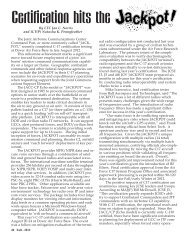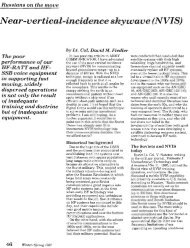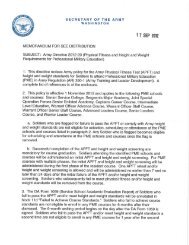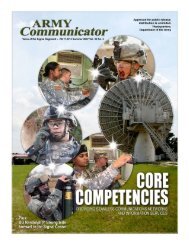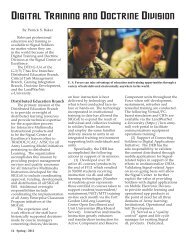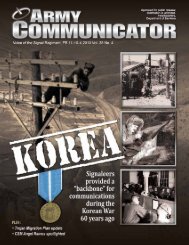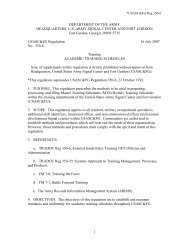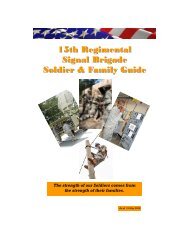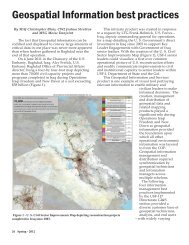AC Summer 08 WIN-T Online - United States Army Signal Center of ...
AC Summer 08 WIN-T Online - United States Army Signal Center of ...
AC Summer 08 WIN-T Online - United States Army Signal Center of ...
You also want an ePaper? Increase the reach of your titles
YUMPU automatically turns print PDFs into web optimized ePapers that Google loves.
ments. The G6<br />
directs the TTSB to<br />
provide communications<br />
support across<br />
the corps battle space<br />
from the BCT level<br />
and below to division<br />
or corps separate<br />
units. Finally, the<br />
corps G6, with<br />
support from the<br />
TTSB NetOps section,<br />
conducts NetOps <strong>of</strong><br />
the tactical network<br />
via the Corps Network<br />
Operations and<br />
Security <strong>Center</strong>.<br />
During OIF 07-<br />
09, the 11th TTSB and<br />
the 18th Airborne<br />
Corps worked very<br />
closely to execute<br />
missions in the<br />
CNOSC; each organization<br />
contributing its<br />
strengths. Task Force<br />
Thunderbird contributed<br />
its engineering<br />
section and 18th<br />
Airborne Corps G6<br />
contributed the<br />
director, senior<br />
network technician,<br />
operations <strong>of</strong>ficer, and<br />
watch <strong>of</strong>ficers. “This<br />
close relationship was<br />
not an accident. We worked very<br />
closely with COL Hildebrand and<br />
developed a relationship before we<br />
ever deployed,” stated COL<br />
Campbell Cantelou, the 18th Airborne<br />
Corps G6. “We sent our<br />
CNOSC Director, LTC Kurt Schosek,<br />
with them when they deployed three<br />
months ahead <strong>of</strong> us.” Schosek and<br />
the 18th Airborne Corps Senior<br />
Network Technician, CW4 Curtis<br />
Newkirk deployed as part <strong>of</strong> Task<br />
Force Thunderbird and assumed<br />
leadership positions in the CNOSC.<br />
“We had a short handed crew before<br />
the 18th Airborne Corps arrived to<br />
fill out the gaps in the CNOSC.<br />
Thunderbirds really pulled together<br />
and completed the CNOSC mission,”<br />
said CW4 Curtis Newkirk,<br />
“When our Soldiers arrived three<br />
months later we had the complete<br />
team we needed for extended<br />
operations.”<br />
“We knew that the first three<br />
months were going to be tough, we<br />
had lieutenants and Sergeants First<br />
Class doing jobs normally filled by<br />
senior captains,” according to MAJ<br />
Glenn Robertson, the Task Force<br />
Thunderbird Network Engineer<br />
Officer. Even before the 18th Airborne<br />
Corps arrived, Soldiers from<br />
both organizations had worked<br />
together to prepare for their assignments<br />
using the MNC-I portal.<br />
Hildebrand and Cantelou agreed,<br />
“Most <strong>of</strong> the leaders in both <strong>of</strong> our<br />
organizations are veterans and have<br />
been in Iraq before. Personalities<br />
mean a lot – the G6 and the <strong>Signal</strong><br />
commander need to be in synch.”<br />
Supporting the corps and division<br />
commanders is too important <strong>of</strong> a<br />
mission to let personal agendas or<br />
pet projects get in the way. Another<br />
important aspect that<br />
both leaders agree<br />
upon is the setting <strong>of</strong><br />
priorities. The G6 sets<br />
the corps’ network<br />
priorities, one <strong>of</strong> which<br />
is a responsive NetOps<br />
that clearly understands<br />
the impacts <strong>of</strong><br />
network modifications<br />
on the BCTs and their<br />
warfighting operations.<br />
Both the Task<br />
Force Thunderbird<br />
commander and the<br />
corps G6 work for the<br />
corps commander<br />
making them equally<br />
responsible and<br />
accountable for corps’<br />
network. “NetOpsand<br />
the assets that support<br />
the corps network<br />
must be responsive to<br />
the corps commander,”<br />
stated Schosek. “Once<br />
you take the accountability<br />
piece out <strong>of</strong> the<br />
hands <strong>of</strong> signal <strong>of</strong>ficers<br />
who work for the corps<br />
commander, NetOps<br />
becomes disjointed and<br />
ineffective.” The<br />
CNOSC with its TTSB<br />
engineering section<br />
and the corps G6 operations section<br />
bring the experience and depth to<br />
provide a CNOSC capable <strong>of</strong> directing<br />
the entire corps network. This<br />
combined effort and relationship<br />
with liaison representatives from<br />
coalition and subordinate divisions<br />
can direct all communications efforts<br />
in the ITO. There is no need to<br />
create an ad hoc pick-up team <strong>of</strong><br />
experts via Joint Manning Document<br />
requests. Only Soldiers and government<br />
representatives accountable<br />
and responsible to the corps commander<br />
should be involved in the<br />
conduct <strong>of</strong> NetOps for the corps<br />
tactical network. The teamwork <strong>of</strong><br />
the corps G6 and the TTSB provide<br />
the right balance <strong>of</strong> both network<br />
monitoring and brigade level<br />
command to the ESBs.<br />
Some proposed that the G6<br />
could direct the employment <strong>of</strong> ESBs<br />
<strong>Army</strong> Communicator 57



